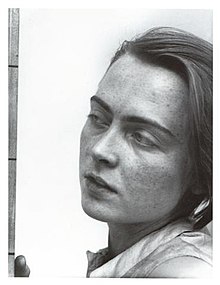Elisabeth Rabbit
Elisabeth Hase (born December 16, 1905 in Döhlen , † October 9, 1991 in Frankfurt am Main ) was a German photographer.
life and work
Elisabeth Hase came to Frankfurt am Main in 1923 and studied from 1924 to 1929 at the Kunstgewerbeschule, later the Städelschule , a. a. when Paul Renner and Willi Baumeister typography and commercial art . She received various awards, including a. in Paris for paper designs and collages . During a two-year collaboration in the studio of Paul Wolff and Alfred Tritschler , Elisabeth Hase carried out initial commissioned work for the China Institute of the University of Frankfurt , and architectural photographs were taken in the New Objectivity style for the magazine “Das Neue Frankfurt” and documentaries on modern housing developments and the like . a. by Ferdinand Kramer . In 1932 Elisabeth Hase started her own business. Her focus was on timeless motifs such as still lifes , structures, plants, dolls, people and especially self-portraits . She received orders and a. the company Thonet , Dr. Oetker, Mouson and Metallgesellschaft. She often used her appearance for self-portraits such as picture stories . Working with agencies such as Holland Press Service and the Schostal agency made it possible for her to publish her photographs internationally.
Despite the bombing of Frankfurt in 1944, the Elisabeth-Hase-Archiv survived the war. In addition to the vintages , glass and film negatives as well as documents could be rescued largely undamaged and are among others. a. in the Folkwang Museum Essen photography collection , in the Albertina in Vienna; in the Walter Gropius estate in the Bauhaus Archive Berlin and in private collections in Germany and abroad. Despite losing her technical equipment in the chaos of war, she resumed her photographic work in 1946 thanks to the help of friends who had emigrated, who provided her with film material and a camera. Are known from this time u. a. their documentation of the destroyed old town and the reconstruction of the Paulskirche in Frankfurt . From 1949 onwards, her main subjects were, in addition to press photos and advertising, mainly plant portraits. Shortly before her death emerged installations of packaging and disposable materials with which they Images built . The titles of these installations refer to the repressed experiences of their generation. In 1991 she died in Frankfurt am Main at the age of 85.
Exhibitions
- 2001 “Woman lens. Photographers 1940-1950 ", House of History in Bonn , (catalog)
- 2003 "Elisabeth Hase - professional photographer", Folkwang Museum , Essen (catalog)
- 2005 Participation in the exhibition "Useful, sweet, and museum / the photographed animal", Folkwang Museum , Essen (catalog)
- 2005/2006 "Elisabeth Hase - a Frankfurt photographer", Historical Museum , Frankfurt am Main
- 2006 Anna Augstein Fine Arts, Berlin
- 2011, participation in the exhibition “Product Policy” Beate Gütschow , together with Albert Renger-Patzsch , Photo Museum Braunschweig
- 2014, WATCH OUT! 100 years of Leica Photography , Deichtor Hallen International Art and Photography, Hamburg
Publications
- "Elisabeth Hase, Portrait of a Photographer" in Photo History Volume 1, Issue 2, 1981, ed. Timm Starl
- Catalog "Elisabeth Hase", Steidl Verlag 2003, Ed. Prof. Ute Eskildsen
- Lohmann, Gabriele: “Elisabeth Hase. Photographer for press and advertising. The 1930s to 50s ”, electron. Diss. Ruhr-Universität Bochum, Bochum 2003 ( online , accessed on January 23, 2015)
- Catalog "useful, sweet and museum / the photographed animal", Folkwang Museum , Steidl Verlag
- “Our time has a new sense of form”, works from the Museum Folkwang's photographic collection , 2012
- Publications with ill. by E. Hase from 1932 in numerous books, newspapers and magazines
| personal data | |
|---|---|
| SURNAME | Hare, Elisabeth |
| BRIEF DESCRIPTION | German photographer |
| DATE OF BIRTH | December 16, 1905 |
| PLACE OF BIRTH | Döhlen |
| DATE OF DEATH | October 9, 1991 |
| Place of death | Frankfurt am Main |
